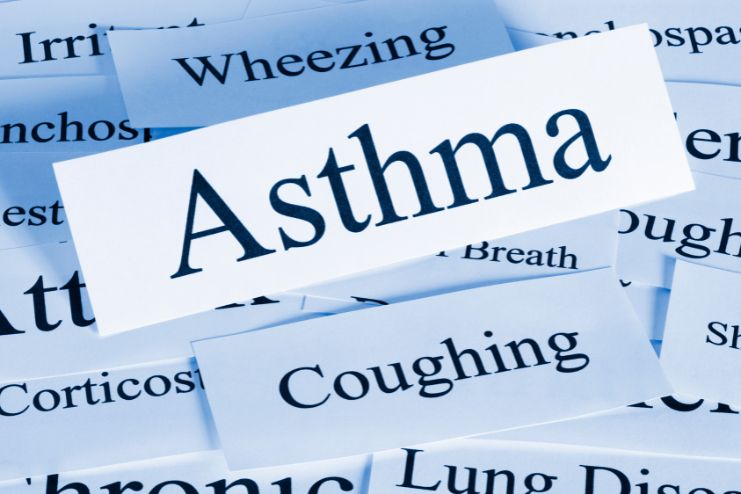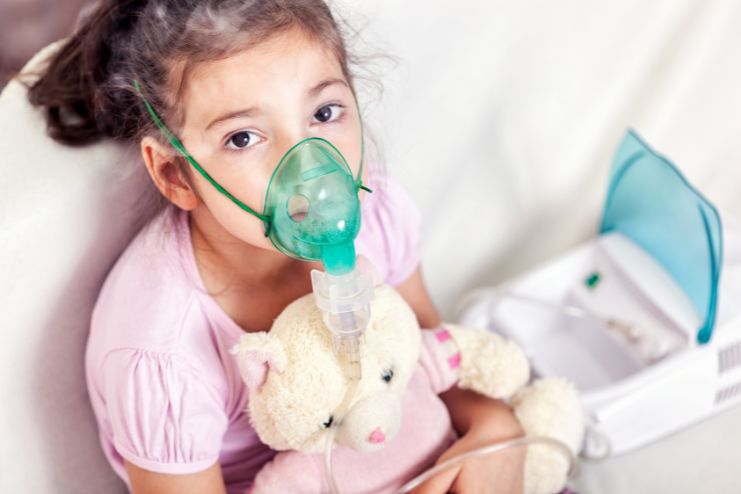AI Contribution
At HealthSpectra, we may use AI to refine grammar and structure, but every piece is shaped, checked, and approved by real people, our expert writers and editors, to ensure clarity, credibility, and care. Learn more..Affiliate Disclaimer
Some links in this article are affiliate links. We may earn a small commission if you make a purchase through these links, at no extra cost to you. We only recommend products we find useful to our readersAsthma is a chronic condition that involves the lungs and makes breathing difficult. It occurs when airways become inflamed, constricted, and clogged with mucus, making it difficult to breathe in and out.
Do you ever feel wheezy or short of breath while exercising or after exposure to dust or smoke? That could be a symptom of asthma, and you’re not the only one—millions of people worldwide have it. Recognizing what causes asthma and how it can be controlled can make life so much more manageable and avert potentially life-threatening attacks.
This article will help you learn about the main symptoms of asthma, typical causes, and how these can be treated with inhalers, lifestyle adjustments, and medication.
Whether you’re living with asthma or know someone who is, learning more about it can make a big difference in staying healthy and in control.
READ MORE: 7 Travel Mistakes to Avoid if You Have Asthma
What is Asthma?

Asthma is a chronic (long-term) condition that impacts the lungs and makes breathing difficult. It causes airways to become inflamed, swollen, and narrower, tending to produce excess mucus.
This results in asthma symptoms such as shortness of breath, chest tightness, coughing, and wheezing. Asthma can strike anyone at any age and tends to develop in childhood, although it can occur at any point in life.
A Chronic and Sometimes Serious Illness
Asthma is not curable and must be controlled regularly. Some individuals have mild symptoms from time to time, but others may have more severe or more frequent attacks.
In a few instances, asthma can be fatal, particularly in the case of a severe asthma attack when the airways become extremely constricted. That is why it is essential to recognize and treat asthma symptoms early.
Triggers and How Asthma Behaves
Asthma symptoms usually become worse when something triggers them. Typical asthma triggers are pollen, dust, pet dander, cigarette smoke, cold air, exercise, stress, and respiratory infections such as colds or flu.
Because everyone’s triggers are unique, it is helpful to know what triggers your symptoms and attempt to stay away from them.
How Asthma Affects Daily Life
Asthma can make normal activities more difficult. Physical exertion, such as walking, running, or participating in sports, could become exhausting. Cold air or pungent odors could make it difficult to breathe.
Uncontrolled asthma can interfere with sleep, induce daytime fatigue, and lead to school or work absenteeism. Most individuals with asthma, though, can enjoy active, healthy lives with the correct treatment and attention.
READ NEXT: Cleaning Products Can Induce Asthma to New Borns
Recognizing the Symptoms of Asthma

Identifying typical symptoms of asthma and the early recognition of triggers are key to the prevention and proper management of the condition in a timely manner, preventing serious flare-ups and keeping the condition under tighter control.
Common Symptoms
- Wheezing: A high-frequency whistling noise generated during respiration, primarily upon exhale.
- Coughing: Often worse at night or early morning, or triggered by cold air or exercise.
- Breathlessness: Having trouble breathing, especially when engaging in light activities.
- Tightness in the chest: A constriction or pressure in the chest region.
These symptoms vary from mild to severe and intermittent. Symptoms occur only in the case of some individuals, which is in response to physical activity or daily, in the case of others.
The frequency and severity typically rely on the category of asthma, including exercise-induced, allergic, or occupational asthma.
Triggers of Asthma Symptoms
Asthma symptoms often get worse when you’re exposed to certain triggers. Recognizing asthma triggers and prevention is key to managing the condition.
Environmental Triggers:
- Dust, pollen, mold, pet dander
- Smoke, air pollution, strong smells
- Sudden changes in weather or cold air
Lifestyle Triggers:
- Physical activity (especially in cold/dry air)
- Emotional stress or strong feelings
- Cigarette smoke or second-hand smoke
Avoiding these triggers and making changes to your environment or routine can help reduce asthma flare-ups and improve your quality of life.
Types of Asthma:
Many types of asthma exist; thus, the triggers, symptoms, and other bronchial characteristics would vary.
- Allergic Asthma: The most common type of asthma, caused by allergens like mold, dust mites, pollen, pet dander, or roach feces. These allergens aggravate the airway inflammation and lead to asthma attacks.
- Non-allergic Asthma: It is different from allergic asthma in that exposure to anything airborne such as a respiratory syncytial virus during an infection can trigger an episode of asthma. Other factors may bring on attacks, including the sudden change of weather or strong smells.
- Exercise-Induced Asthma (EIA): Physical activity that includes strenuous workouts while exposed to dry or cold air can result in asthma symptoms such as wheezing, coughing, or difficulty breathing. Signs are usually felt at the time of exercise or soon after.
- Aspirin-Exacerbated Respiratory Disease (AERD): Appears in patients who are hypersensitive to aspirin or other nonsteroidal anti-inflammatory agents (NSAIDs). After taking aspirin, symptoms may include shortness of breath, sneezing, nasal obstruction, and wheezing.
- Cough-Variant Asthma (CVA): Typified primarily by a dry cough that can be chronic and occur mostly at night or during sleep. It may not have features of wheezing or difficulty breathing, but this type of asthma may occur in both children and adults.
- Occupational Asthma: Results from irritants in work environments, like chemicals, dust, fumes, and mold. The symptoms improve in most people while resting at home, but worsen once they are back at work.
READ MORE: 10 Triggers That Could Worsen Your Asthma
What Causes Asthma?

Knowing the causes of asthma is important in its prevention and in managing the disorder more effectively.
Genetic Factors
One of the main causes of asthma is genetics. If asthma runs in your family, you’re more likely to develop it too.
Certain genes can make your airways more sensitive to things like dust, pollen, or pollution. Children with parents or close relatives who have asthma are especially at risk of developing it themselves.
Environmental Factors
Your environment can also play a big role in triggering asthma or causing it to develop in the first place, especially during early childhood.
- Allergens: Major allergens include pollen, mold, pet dander, and dust mites.
- Air Pollution: Air pollution, especially in cities or industrially developed areas, can harm the lungs and lead to asthma. Tiny, harmful particles within the air, known as particulate matter, are quite concerning.
- Respiratory Infections: Early-life viral lung infections can predispose a person to develop asthma later in life.
These environmental factors can make the lungs progressively more sensitive, raising the likelihood of asthma exacerbations or even its initial onset.
Other Risk Factors
Lifestyle Factors:
- Smoking: Active smoking and second-hand smoke exposure are significant risk factors. Smoke makes the lungs irritable and can result in chronic breathing issues.
- Obesity: Being overweight may complicate asthma symptoms because it puts added pressure on the lungs and causes more inflammation in the body.
Occupational Asthma:
- Asthma may develop for some due to exposure to chemicals, fumes, or dust in the workplace. Careers involving farm work, cleaning, or manufacturing tend to be at greater risk.
By knowing what causes asthma—genetic and environmental—you can do your part to avoid triggers and control the condition more effectively.
This is the foundation of preventing attacks and aiding in chronic respiratory illness long-term control, particularly for people with chronic respiratory diseases.
READ NEXT: 7 Breathing Exercises to Fight Asthma
Diagnosing Asthma

Early and correct diagnosis is critical to effective asthma diagnosis and management, enabling individuals to enjoy healthier, more active lifestyles.
Methods of Diagnosis
Medical History: Physicians begin by evaluating your symptoms—wheezing, coughing, chest tightness, or shortness of breath—and your family history. Individuals with a family history of asthma or allergy can develop asthma.
Physical Examination: The physician will conduct a physical examination to listen to the sound of your lungs and rule out other conditions that could have similar symptoms to asthma.
Diagnostic Tests
- Spirometry: This is a routine lung function test that measures how much air you can exhale and how quickly. It assists physicians in establishing airway obstruction.
- Peak Flow Measurement: Assesses how quickly you can exhale. Decreased readings could indicate asthma.
- Methacholine Challenge Test: This test involves a chemical that can constrict your airways. If it provokes symptoms, asthma is probable.
- FeNO Test (Fractional Exhaled Nitric Oxide): Measures inflammation in your lungs, which is common in asthma.
These tests provide essential insights that support a thorough asthma diagnosis and management plan tailored to your condition.
The Role of a Doctor and When to Seek Help
Getting diagnosed by a healthcare provider is important for long-term care. They create a personalized treatment approach, which often includes medication, lifestyle changes, and an asthma action plan.
Dr. David G. Hill of the American Lung Association says, “Diagnosing asthma requires a comprehensive approach that includes understanding the patient’s symptoms, conducting lung function tests, and assessing environmental and genetic factors. This ensures a tailored treatment plan for effective management.”
A precise diagnosis provides the groundwork for a successful asthma action plan, enabling individuals to monitor symptoms, stay away from triggers, and act fast when worsening occurs.
An asthma attack can be serious and may happen when symptoms suddenly get worse. Watch for:
- Severe shortness of breath or rapid breathing
- Inability to talk or walk comfortably
- Blue lips or fingernails
- No relief after using a rescue inhaler
In these cases, get emergency medical help immediately.
READ MORE: 10 Effective Yoga Asanas for Asthma Relief
Treatment Options for Asthma

Several treatment avenues are available for asthma today that allow people to keep symptoms in control and enjoy active, healthy lifestyles. Treatment involves using the proper medications and incorporating healthy lifestyle behaviors to prevent flare-ups.
Medications
- Reliever (Rescue) Medications: These fast-acting drugs are used during asthma attacks or when symptoms suddenly appear. Short-acting beta-agonists (SABAs), like albuterol, quickly relax the muscles around your airways. These are considered essential, effective asthma medications for quick relief in emergencies.
- Preventer (Controller) Medications: These medicines are used daily to reduce swelling and mucus in the airways. Inhaled corticosteroids are the most common type, and long-acting bronchodilators (LABAs) are often added if symptoms are frequent. Together, they form a strong line of defense against flare-ups.
- Combination Inhalers: These inhalers contain both a steroid and a bronchodilator, offering long-term control and symptom relief in one device. They’re a helpful option when single medications are not enough.
- Biologic Treatments: For people with severe asthma that doesn’t respond to regular medicines, biologics like monoclonal antibodies (e.g., omalizumab or dupilumab) may be prescribed. These target specific immune responses that cause asthma symptoms.
Non-Medication Approaches
- Breathing Exercises: Techniques such as pursed-lip or belly breathing can help improve airflow and calm breathing. Practicing these can reduce stress during an asthma episode.
- Lifestyle Changes: Avoiding asthma triggers like pollen, smoke, and pet dander is essential. Staying physically active, eating well, and maintaining a healthy weight all support lung health and asthma control.
Emergency Treatment
During a severe asthma attack, when breathing becomes very difficult and rescue inhalers don’t help, emergency care is critical. Oral corticosteroids or hospital treatment may be needed.
That’s why having a clear asthma action plan created with your doctor is so important—it tells you what to do when symptoms get worse.
With a combination of effective asthma medications and smart lifestyle choices, most people can successfully manage their condition through a range of asthma treatment options.
READ NEXT: How to Control Asthma Naturally?
Managing Asthma Long-Term

Asthma is an illness that requires regular care and management. By adopting the proper plan and lifestyle, most individuals are able to control their symptoms and avoid serious attacks. Keeping the disease controlled is the way to live with asthma.
Asthma Action Plan
A personalized asthma action plan is essential for keeping asthma under control. This plan, made with your doctor, tells you what to do daily, how to adjust treatment if symptoms worsen, and when to seek emergency help. It includes:
- A list of daily medications, including inhalers for asthma
- Signs that your condition is getting worse
- Clear steps to follow during an asthma flare-up
- Emergency contacts
This plan helps you act quickly and correctly, reducing the risk of serious health issues.
Monitoring Asthma
Monitoring your asthma daily informs you whether it is controlled or not. Devices such as peak flow meters gauge how much air you can breathe out, alerting you to a potential asthma attack even when the symptoms have yet to appear.
Keeping a diary of symptoms is also helpful. Record how you feel, symptom changes, and what could have caused them. Your doctor may be able to adjust your medication or suggest changes to your daily routine based on this record.
Lifestyle Tips
Daily habits make a big difference in managing asthma long-term. Here are a few useful strategies:
- Stay active: Regular physical activity strengthens your lungs. Consult your physician about safe exercise practices.
- Avoid triggers: Steer clear of things like smoke, strong odors, pollen, dust mites, and cold air. These are common asthma attack signs in sensitive individuals.
- Manage stress: Emotional stress can worsen symptoms. Try deep breathing, yoga, or calming routines to stay relaxed.
- Take medications properly: Never skip your daily meds, especially preventive inhalers for asthma, even if you’re feeling okay.
Recognizing asthma attack signs early—like chest tightness, shortness of breath, wheezing, or coughing—can help you act fast and avoid emergencies. With the right mix of medical support, tracking tools, and lifestyle adjustments, asthma can be well-managed every day.
READ MORE: 5 Best Cities for People with Asthma
Natural Remedies and Lifestyle Changes

Asthma involves more than the use of medicines—it also encompasses healthy lifestyle changes. Although prescribed medications by the doctor are unavoidable, natural home remedies and routines can aid in easier breathing and assist in alleviating symptoms.
Natural remedies and these habits should serve as supplements and not substitutes for medical treatment.
Natural Approaches
Certain natural home remedies can alleviate and ease symptoms of asthma:
- Honey: Frequently utilized as a throat soother and a cough suppressor.
- Ginger: Ginger, which has anti-inflammatory properties, could be used to relax muscles in the airways.
- Steam inhalation: Inhalation of steam can relieve tightness in the chest and thin out mucus.
While beneficial, these treatments are not cures and are to be taken in combination with medications prescribed, particularly for the control of asthma in children and adults, where the symptoms may be variable in frequency and severity.
Diet and Nutrition
The correct foods can make a huge difference in asthma control:
- Omega-3 fatty acids: Fatty fish such as salmon and flax seeds have anti-inflammatory effects on the airways.
- Antioxidants: Vitamins C and E, present in fruits and vegetables, are antioxidants that help protect lung tissue.
- Vitamin D: A deficiency is associated with increased asthma symptoms; obtain it from sunlight and foods such as fortified milk and eggs.
Steer clear also of foods that could bring about asthma symptoms, including:
- Dairy products: They can be a mucus-increasing item for some.
- Sulfites: Found in dried fruits, processed foods, and wine—can trigger breathing difficulties in susceptible individuals.
READ NEXT: Nasal Breathing vs. Mouth Breathing: Which is Better?
Living with Asthma: Tips for a Better Quality of Life

It may be difficult living with asthma, not only physically but emotionally as well. One must take control of both the psychological and physical aspects of this chronic respiratory condition in order to have a healthy, balanced lifestyle. These are some useful tips.
Psychological Impact
Asthma doesn’t just impact your lungs—it can affect your mood too. Chronic occurrences of wheezing and shortness of breath, particularly during an asthma attack, can lead to anxiety and fear.
Children and adults can become self-conscious about their limitations or worry about what might trigger their symptoms.
To manage the emotional aspect:
- Develop stress-relieving techniques such as deep breathing exercises, meditation, or relaxation yoga.
- Get professional help if you’re feeling constantly anxious or depressed.
- Join groups where you can meet others coping with asthma—it’s reassuring to know you’re not alone.
A clear head can make you more confident in controlling your condition.
Preventative Measures
Prevention is the key to long-term control of asthma. Being one step ahead can cut down on the number of symptoms and make you feel better overall.
- Vaccinations are important. Yearly flu vaccinations and other regular immunizations (such as pneumonia or COVID-19 vaccinations) lower your risk of getting respiratory infections that might trigger an asthma attack.
- See your doctor regularly to monitor your symptoms and modify your treatment plan as appropriate.
- Develop an individualized asthma action plan with your doctor so that you can respond promptly to increasing symptoms.
Staying away from asthma’s typical triggers—dust mites, pollen, smoke, and potent odors—can also keep wheezing and breathlessness episodes under control.
Good habits also make a difference:
- Eat well and have a normal weight.
- Stay fit by using the exercise techniques advised by your doctor.
- Get adequate rest and take control of related allergy problems.
With the right strategy, asthma does not need to restrict your lifestyle. Through mental health emphasis, avoidance of asthma triggers, and a straightforward plan, you can breathe easier and live better.
READ MORE: 10 Breathing Support Products to Enhance Lung Health
Conclusion

Asthma is a chronic disease of the lungs with symptoms such as wheezing, coughing, chest tightness, and shortness of breath. Asthma can be set off by allergens, pollution, exercise, and stress. Although there are no asthma cures, asthma can be well monitored with the correct medication, education, and lifestyle changes.
Medication management – including inhalers, controller medications, and rescue medication – can help ensure we can keep symptoms at bay and the lungs performing normally. If you are diagnosed with asthma, it’s very important to note that you can live a full, active life.
You just have to avoid your triggers and make small lifestyle changes. The sooner asthma is diagnosed, and the patient receives regular check-ups with their doctor, the better.
Patients should also complete an asthma management plan, avoid and limit triggers, and follow their asthma action plan, which will make all the difference.
Do you have any suggestions or experiences with asthma medication? Feel free to write down any comments below. The more you learn, the more you can take charge of your asthma condition.
There is hope that people with asthma will live great and productive lives. Take control today, and breathe easy tomorrow.
References
- https://my.clevelandclinic.org/health/diseases/6424-asthma
- https://www.who.int/news-room/fact-sheets/detail/asthma
- https://www.mayoclinic.org/diseases-conditions/asthma/symptoms-causes/syc-20369653
- https://www.webmd.com/asthma/what-is-asthma
- https://www.mayoclinic.org/diseases-conditions/asthma/symptoms-causes/syc-20369653
- https://www.webmd.com/asthma/asthma-symptoms
- https://www.nhlbi.nih.gov/health/asthma/symptoms
- https://medlineplus.gov/asthma.html
- https://www.lung.org/lung-health-diseases/lung-disease-lookup/asthma/learn-about-asthma/what-causes-asthma
- https://www.pennmedicine.org/for-patients-and-visitors/patient-information/conditions-treated-a-to-z/asthma
- https://aafa.org/asthma/asthma-triggers-causes/air-pollution-smog-asthma/
- https://www.lung.org/lung-health-diseases/lung-disease-lookup/asthma/symptoms-diagnosis/how-is-asthma-diagnosed
- https://www.mayoclinic.org/diseases-conditions/asthma/diagnosis-treatment/drc-20369660
- https://www.nhlbi.nih.gov/health/asthma/diagnosis
- https://www.medicalnewstoday.com/articles/how-is-asthma-diagnosed
- https://www.nhlbi.nih.gov/health/asthma/treatment-action-plan
- https://www.mayoclinic.org/diseases-conditions/asthma/in-depth/asthma-medications/art-20045557
- https://www.webmd.com/asthma/asthma-treatments
- https://www.mayoclinic.org/diseases-conditions/childhood-asthma/diagnosis-treatment/drc-20351513
- https://pubmed.ncbi.nlm.nih.gov/12619955/
- https://www.nhlbi.nih.gov/health/asthma/treatment-action-plan
- https://pharmaceutical-journal.com/article/ld/asthma-long-term-management
- https://pmc.ncbi.nlm.nih.gov/articles/PMC7491342/
- https://allergyasthmanetwork.org/what-is-asthma/lifestyle-changes-to-manage-asthma/
- https://allergyasthmanetwork.org/what-is-asthma/natural-asthma-treatments/
- https://www.medicalnewstoday.com/articles/home-remedies-for-asthma
In this Article


















